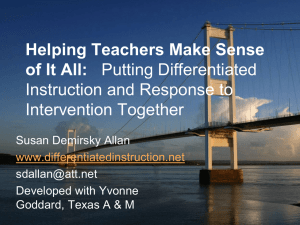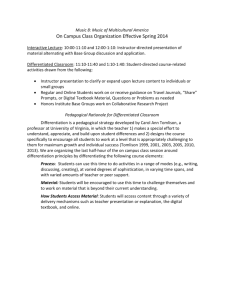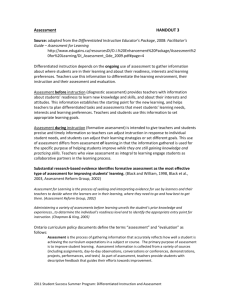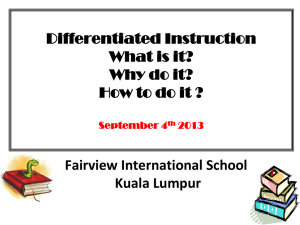Differentiation and the Brian
advertisement
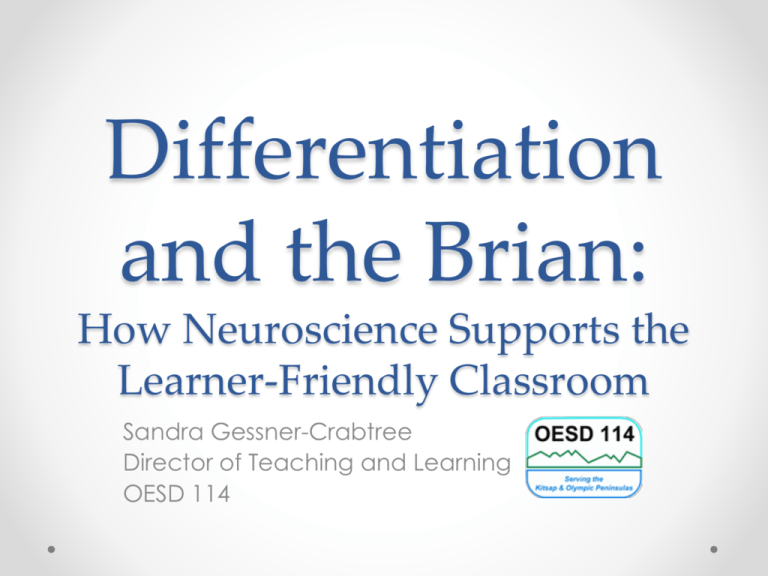
Differentiation and the Brian: How Neuroscience Supports the Learner-Friendly Classroom Sandra Gessner-Crabtree Director of Teaching and Learning OESD 114 Differentiation “Differentiated instruction is a teaching philosophy based on the premise that teachers should adapt instruction to student differences. Rather than marching students through the curriculum lockstep, teachers should modify their instruction to meet students’ varying readiness levels, learning preferences, and interests. Therefore, the teacher proactively plans a variety of ways to ‘get at’ and express learning.” Carol Ann Tomlinson Activator • Discuss Tomlinson’s quote with an elbow partner or two elbow partners reflecting on what you already do in your classroom that fits this definition. • Consider how your instructional framework addresses differentiation. • Jot down three ways differentiation is already present in your instructional practice. • Be prepared to share. Key Principles of a Differentiated Classroom • The teacher is clear about what matters in subject matter. • The teacher understands, appreciates, and builds upon student differences. • Assessment and instruction are inseparable. • The teacher adjusts content, process, and product in response to student readiness, interests, and learning profile. • All students participate in respectful work. • Students and teachers are collaborators in learning. • Goals of a differentiated classroom are maximum growth and individual success. • Flexibility is the hallmark of a differentiated classroom. Learning Targets • Gain insight into the neuro science that supports Differentiated Instruction • Understand the essential elements of Differentiated Instruction Success Criteria • Articulate: If the brain science says this ___________, then I need to add this ______________ into my instructional practice. • Discuss with a colleague or significant other two or three key findings from brain research that impact the learning process • Discuss with a colleague or significant other two or three ways differentiated instruction could improve learning outcomes for students How Does Research Support DI? • Differentiated Instruction is the result of a synthesis of a number of educational theories and practices. • Brain research indicates that learning occurs when the learner experiences moderate challenge and relaxed alertness –readiness • Psychological research reveals that when interest is tapped, learners are more likely to find learning rewarding and become more autonomous as a learner. Brain Research • Each brain is uniquely organized • The brain is a lean pattern-making machine • The brain’s frontal lobe is often referred to as the “executive center” directing much of the brain’s activity • Emotions are processed in the limbic system and play an important role in pattern making • Learning is as much a social process as it is a cognitive one • If content is meaningful, it is likely to be transferred from working to long-term memory • Learning for retention requires focus and extended attention. Diving In Together • Protocol • 3 Types of text o Visually based with text bullets o Research article o Text from book • Individual processing time o During reading • Check for “got it” √ • Exclamation point for “love this” or “totally agree” ! • Question mark for “I need to know more about this” • Together In Triads to discuss ? Take Aways • Group Discussion • Reflection o Write down three “Take Aways” from the brain research that you feel is relevant to your instructional practice. Break A Model for Effective Differentiation What DI Is and Is Not Differentiation Is • …A philosophy rooted in effective teaching and learning • …Regularly Examining evidence of student learning and making thoughtful instructional decisions accordingly • …Tailoring instruction in response to patterns in student needs Differentiation Is Not • … A bag of tricks or set of strategies that can be plunked into low-quality curriculum. • …Either an everyday necessity or a once-in-ablue-moon “event.” • Writing individualized plans for every student. What DI Is and Is Not, cont. Differentiation Is Differentiation Is Not • …Designing respectful tasks and using flexible grouping. • …A way up to standards and learning goals. • …Critical to improving instruction for all students. • ... Sorting or pigeonholing students into static groups or levels. • …A way out of standards and learning goals. • …More important for certain groups of students (e.g., students with IEPS or English Language Learners) Five Key Principles of the Model • Work in a differentiated classroom is respectful of each student. Every student’s work is equally engaging. • Curriculum, or what students are asked to learn, is rooted in the critical ideas of a topic or a discipline. It is designed to promote understanding, rather than just recall. • Teachers regularly use flexible grouping. Just as they plan the sequence of ideas necessary for learning, they plan a variety of grouping configurations for each stage of the learning process. Based on: o Readiness o Interest o Learning preferences Principles, cont. • Teachers use ongoing assessment to inform their instruction. Being clear at each stage of the learning process about what students should know, understand, and be able to do. • The learning environment supports students in taking the risk of learning. A positive environment attends to students’ affective needs for acceptance, respect, affiliation, contribution, challenge and support. Key Vocabulary Learning Environment Curriculum Quality Assessment Groupings o Readiness o Interest o Learning Preferences/Profiles • Classroom Management • • • • Learning Environment Positive Environment Leads to • Endorphins in bloodstream, which o Generate feeling of euphoria o Raise pain threshold o Stimulate the frontal lobe so that the situation and the learning objectives are remembered. Negative Environment Leads to • Cortisol in bloodstream, which, o Raises anxiety level o Shuts down processing of lowpriority information( for example, the lesson objective) o Focuses frontal lobe on the cause of the stress so that the situation is remembered, but not the learning objective Curriculum: Course of Study Quality Curriculum Organized around essential content goals Aligned with content goals, assessments, and learning experiences Focused on student understanding Engaging for students The nature of what we teach (curriculum), sharply affects the impact of how we teach ( differentiation) Authentic Classroom Assessment • Effective classroom assessment addresses academic diversity: o Formative assessment is the prelude to effective differentiation. o Effective assessment practices ( pre-assessment, formative, summative) is integral to ensuring that students and teachers alike work from a growth mindset ( effort is the key determiner of success.) o Effective use of pre-assessment strengthens teacher-student connections because information from the assessments helps teachers learn about their students and support their growth o Pre-assessment and formative provides instructionally relevant information about student readiness, interest, and learning profiles. o Providing feedback rather than grades in the formative process ensures that students who struggle with the content have adequate practice time before their work is judged o Using assessment for learning increases student ownership, performance and efficacy. DI in Response to Student Readiness • Readiness ≠ ability • Vygotsky’s Zone of Proximal Development • Content, Process and Product o o o o o o o o o Small groups for students with similar needs Use complex or more straightforward task directions for some students Differentiated homework Use multiple materials at different reading levels Learning contracts Tiering Providing supports Frontloading key academic vocabulary Assigning varied work at skill centers DI in Response to Student Interest • Interest refers to a feeling or emotion that causes an individual to focus on or attend to something because it matters to that individual. • Content, Process, Product o Provide instructional resources that can help students relate essential content to their areas of interest. o Show examples of skill applications in areas students are in and how the skills apply in real-world settings o Provide opportunities for students to apply skills in relevant areas of interest o Provide models of student or expert work in relevant areas o Authentic product assignments- student choose context in which to demonstrate their understanding of learning essentials o Students set personal goals for their interest-focused products DI in Response to Student Learning Profile • Learning profile relates to how people “come at” learning: learning styles, intelligence preferences, culture and gender • Content, Process, and Product o Students examine their own preferred styles of learning o Expand modes of presentations: visual, auditory, demonstration, creative questioning o Use graphic organizers o Teach part to whole as well as whole to part o Choice of working conditions o Call on students equitably o Include collaborative and competitive tasks o Have students play roles that require them to examine other perspectives o Develop tasks with a more concrete focus and tasks with more abstract Activity • Protocol • Two Articles: preference based on interest and relevance Differentiation in a Nutshell • “Effective differentiation does not call on a teacher to be all things to every student at all times of the day. Rather, it calls on teachers to be constantly mindful of three things: 1) how their content is structured for meaning and authenticity, 2) who their students are as individuals, and 3) which elements in their classrooms give them degrees of freedom in connecting content and learners.” o Tomlinson and Sousa, Differentiation and the Brain, pl. 15 Resources How Did We Do? • Learning Targets: o Gain insight into the neuro science that supports Differentiated Instruction o Understand the essential elements of Differentiated Instruction • Success Criteria: o Articulate: If the brain science says this ___________, then I need to add this ______________ into my instructional practice. o Discuss with a colleague or significant other two or three key findings from brain research that impact the learning process o Discuss with a colleague or significant other two or three ways differentiated instruction could improve learning outcomes for students Thank You Sandra Gessner-Crabtree Director of Teaching and Learning OESD 114 sgessner@oesd114.org


